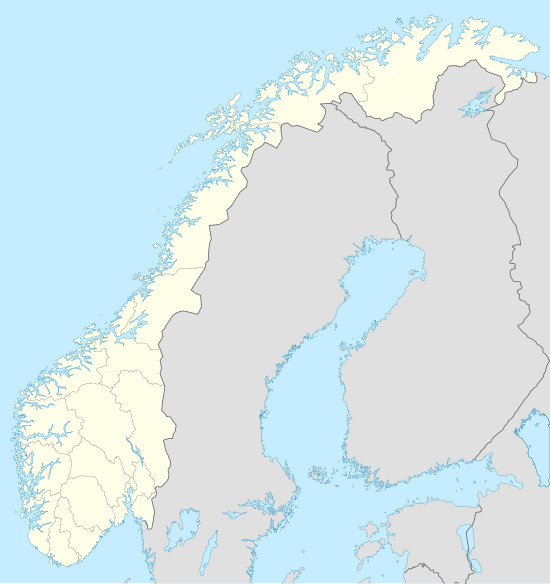Drøbak
| Drøbak | |
|---|---|
| Unincorporated city | |
|
Drøbak from harbor area | |
 Drøbak Location within Norway | |
| Coordinates: 59°40′N 10°38′E / 59.667°N 10.633°E | |
| Country | Norway |
| County | Akershus |
| District | Follo |
| Municipality | Frogn |
| City status (regained) | 13 February 2006 |
| Government | |
| Population (2006) | |
| • Total | 11,514 |
| • Density | 1,688/km2 (4,370/sq mi) |
| Time zone | CET (UTC+1) |
| • Summer (DST) | CEST (UTC+2) |
Drøbak is a town and the centre of the municipality of Frogn, in Akershus county, Norway. The city is located along the Oslofjord, and has 13,358 inhabitants.
History
Drøbak and Frogn was established as a parish on its own through a royal decree Sept. 8, 1823. It had been a part of Ås parish.
Drøbak was established as a municipality January 1, 1838 (see formannskapsdistrikt). It was merged with Frogn January 1, 1962.

Traditionally, Drøbak was the winter harbour of Norway's capital, Oslo, since in severe winters the fjord will freeze from outside Drøbak all the way up to Oslo. It had a city status between 1842 and 1962, upon which point the municipality was merged into the rural municipality Frogn and lost its city status. The city status was regained by the municipality council on 13 February 2006. It was also decided that adjacent villages such as Heer would be included within the city.[1]
A notable event in Drøbak's history is the World War II sinking of the German cruiser Blücher in the Drøbak narrows (only 1 mile (1.5 km) wide), on the early morning of 9 April 1940. The cruiser was transporting German soldiers and bureaucrats for the planned swift occupation of Oslo, but the Battle of Drøbak Sound resulting in the sinking by the Oscarsborg fortress delayed this, and thus allowed for the evacuation of the Norwegian Royal Family, parliament, and cabinet, and for the nation's gold reserves to be denied the occupiers.[2]
Early Drøbak had ferries that crossed the fjord, in modern times they have largely been replaced by an underwater tunnel. However, some of the old ferries are still used as "floating restaurants" during the summer.
Tourism
In summertime, cruise ships visit Oslo almost every day. Often, as many as four or five cruise ships visit each day, in addition to all the regular traffic, it has made Drøbak a popular sea-side tourist spot. However, the numerous restaurants, art galleries and mild summers are probably more important factors for visiting tourists.[3]
Drøbak is also known for its many art galleries. The town has a Christmas shop called Julehuset (the Christmas house), and letters often end up in Drøbak from Europe similarly to how they end up in Santa Claus, Indiana in the United States.[4]
During the summer months, there are tourist buses going from Oslo to Drøbak on day trips for tourists. Visitors can experience a traditional Norwegian fjord town. It is also a popular Oslo suburb for citizens to live as public transportation is well connected between Drøbak and Oslo, both by bus and boat.
A small aquarium with local species of fish and shellfish is open to the public and shows live video footage of the sea life in the fjord where fish, lobster and crab are often visible for the aquarium visitors. [5]
Norsk Luftambulanse is headquartered in Drøbak.[6]
The name
The Norse form of the name was Drjúgbakki. The first element is drjúgr 'hard; long', the last element is bakki m '(up)hill'. This is related to the very steep hills upon which main road into Drøbak Center winds.
Places

Drøbak is divided into eight notable areas. These places include:
- Gyltåsen, which mainly consists of cabins and "season-housing".
- Husvik, where most of the year-around boats are being kept. This area was also significant in the sinking of the German cruiser Blücher in 1940, as the location of the Husvik Battery of Oscarsborg Fortress. The guns of the battery are still in place in these hills as tourist attractions.
- Sentrum (city centre), here lies "Julehuset" and most of the local stores. Most of the City Centre is being protected by local laws as "Verneverdig" which in short terms means that it has a significant cultural value and cannot be changed or rebuilt. Therefore, much of the city centre looks like it did 100 years ago.
- Skiphelle and Elleflaten, an area consisting of suburban housing and a tiny hotel called "Drøbak Fjordhotel".
- Sogsti, consisting of much of Drøbak's suburban housing.
- Odalen and Haveråsen is the "outer banks" of Drøbak, where the housing and population consists more of agricultural purpose.
- Belsjø and Heer, the suburban housing around the large golf course surrounding most of northern Drøbak.
- Ullerud and Dyrløkke, a large hill of suburban housing. Here are also the local mall and a large school up to high school level.[7]
See also
References
- ↑ •Sørensen, Rolf m.fl.: Frogn bygdebokverk, Frogn kommune, 1996-, 5 b. (in Norwegian), ISBN 82-993990-0-9
- ↑ Oscarsborg Fortress(in English)
- ↑ •Drange, Erling: Drøbak fra nord til syd : husene forteller historie (2001), (in Norwegian) ISBN 82-996109-0-7
- ↑ Julehuset (The Christmas house) Archived December 30, 2012, at the Wayback Machine. (in English)
- ↑ Drøbak Akvarium (in Norwegian)
- ↑ Norsk Luftambulanse, Headquarters in Drøbak (in Norwegian)
- ↑ Drøbak at Store norske leksikon (in Norwegian)
External links
| Wikimedia Commons has media related to Drøbak. |
- Visit Drøbak (in English)
- Introduction to Drøbak (in English)
- A taste of Drøbak VIDEO (in English)
 Drøbak travel guide from Wikivoyage
Drøbak travel guide from Wikivoyage
Coordinates: 59°40′N 10°38′E / 59.667°N 10.633°E

